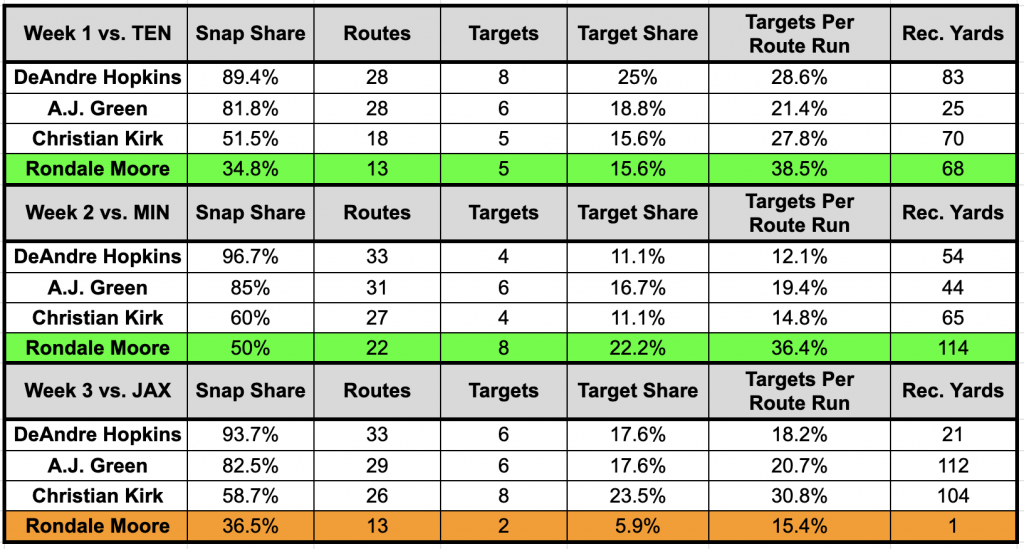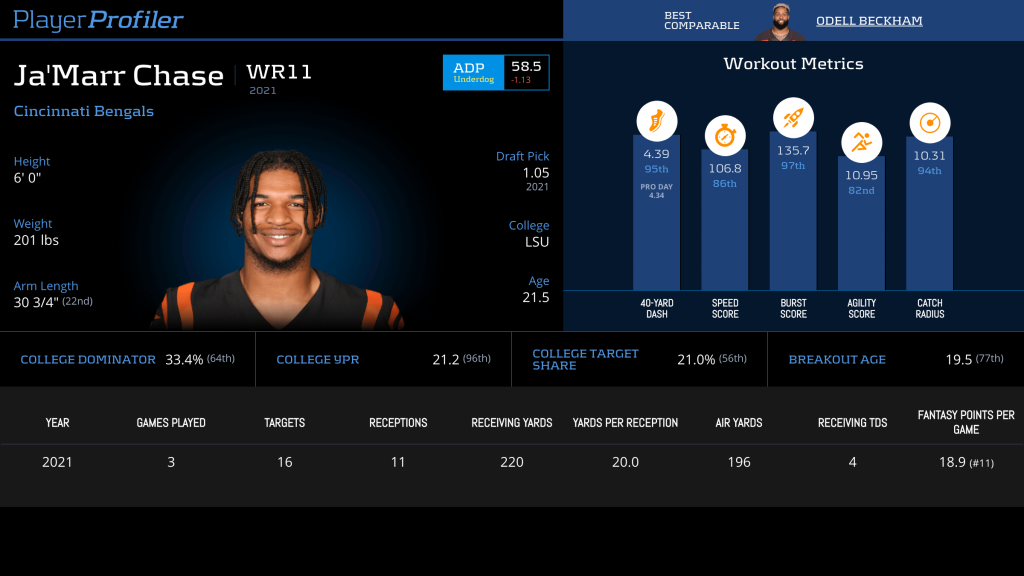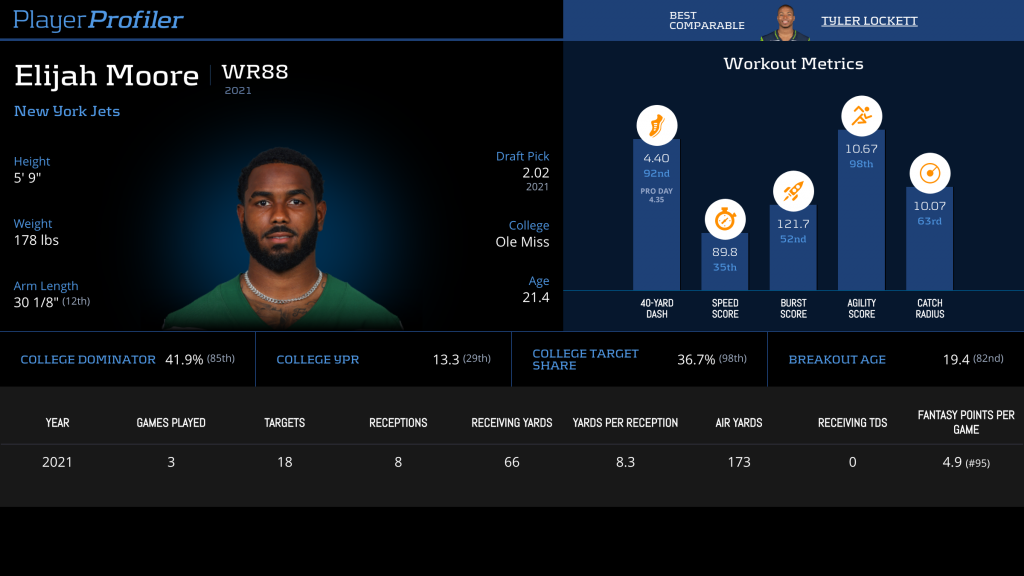As we close in on the first quarter of the NFL season, we’ll break down the high and low-efficiency outliers at wide receiver. Most of these receivers end up in starting lineups more often than not, while a couple may fit more in deeper leagues with multiple flex spots. It’s a fun and eye-opening exercise to use the Data Analysis Tool to sort through the efficiency outliers at different positions. Like with any metric, context matters, so we must take into account multiple factors. Let’s run through the process of identifying efficiency outliers and what we should expect moving forward.
Top Efficiency Outliers at Wide Receiver
Tyler Lockett
Amongst receivers with 15 or more targets, three receivers stood out atop the efficiency outliers leaderboard. Those receivers include Tyler Lockett, Christian Kirk, and Ja’Marr Chase. Part of their efficiency came via touchdowns. Lockett smashed in Week 1 and 2 with 28.9 fantasy points on average for two top-8 performances. Then a dud in Week 3 with 7.1 (No. 63 among qualified wide receivers) fantasy points.
It’s not just the 18.8-percent touchdown rate for Tyler Lockett, but also an uber efficiency outlier with 15.5 (No. 5) Yards Per Target, 3.77 (No. 6) Yards Per Route Run, and a +35.7 (No. 10) Production Premium. Fortunately, the opportunities remain consistent and solid, evidenced by a 25.0-percent (No. 22) Target Share, 38.8-percent (No. 15) Air Yards Share, and 14.5 (No. 18) Average Target Distance. Monitor Lockett’s injury status in Week 4. He logged a limited practice session with a hip issue. However, when healthy, the Russell Wilson and Lockett connection stays fruitful with Wilson’s uber-efficient 11.0 (No. 2) Adjusted Yards Per Attempt.
Christian Kirk
Are we witnessing Christian Kirk‘s fourth-year breakout season? After two touchdowns in Week 1, Kirk averaged 84.5 receiving yards in Week 2 and 3. However, the Cardinals keep spreading the ball around, with DeAndre Hopkins and A.J. Green seeing the field a ton via snap share. Kirk’s opportunities look gross with a 56.6-percent (No. 83) Snap Share, 17-percent (No. 57) Target Share, and 27.4-percent (No. 44) Air Yards Share.
However, Kirk provided efficient production as the No. 16-ranked receiver with 17.0 Fantasy Points Per Game. Similar to Tyler Lockett, Kirk has averaged 14.1 (No. 6) Yards Per Target, 3.37 (No. 10) Yards Per Route Run, and logged a +35.2 (No. 11) Production Premium. From a real-life standpoint, Kirk also ranks No. 2 with 26.5 Expected Points Added (EPA). Thankfully, Kirk and Lockett pair with two of the most efficient quarterbacks, evidenced by Kyler Murray‘s 9.0 (No. 4) Adjusted Yards Per Attempt. Earlier in the offseason, I wrote up an article on this metric here.
Ja’Marr Chase
But, but I heard we should fade Ja’Marr Chase because of drops during the preseason? Hopefully, folks didn’t fade Chase too hard, even though he could end up on a sell-high list as a top efficiency outlier. Through three games, Chase garnered a ridiculous 46.8-percent (No. 5) Air Yards Share and 17.3 (No. 9) Average Target Distance with a mediocre 21.9-percent (No. 33) Target Share. Sure, Chase’s 33.3-percent Touchdown Rate isn’t sustainable, but the opportunities should increase to even out some efficiency outliers like him.
Other notable efficiency metrics for Chase include 13.8 (No. 8) Yards Per Target, 2.86 (No. 15) Yards Per Route Run, and a +28.9 (No. 12) Production Premium. So far, Chase checks several boxes early on with efficient production, high Air Yards Share, and above-average prospect talent.
Chase performed well in Thursday’s juicy matchup, evidenced by six catches on nine targets (28.1-percent) for 77 receiving yards. After Joe Burrow averaging 25 (No. 31) Team Pass Plays Per Game, he attempted a season-high 32 pass attempts. The volume should increase slightly, but it’s surprising to see Burrow’s early-season efficiency with a +22.0 (No. 1) Production Premium. However, there’s still room for improvement with a 7.1 (No. 20) Adjusted Yards Per Attempt.
Bottom Efficiency Outliers at Wide Receiver
Elijah Moore
We’ll use the same threshold of 15 targets, and Elijah Moore ranks as one the worst efficiency outliers at wide receiver. Unfortunately, Zach Wilson and the Jets offense look brutal so far. The Jets have an awful -11.02 (No. 32) Game Script and rank middle of the pack with 35 (No. 16) Team Pass Plays Per Game. What’s even worse, they have the slowest Pace of Play at 1.42 plays per minute. A brutal offense that can’t move the ball with a low Pace of Play makes sense, but it doesn’t help the Jets pass-catchers.
The funniest stat line for a receiver involves Moore. In Week 1, he caught one of four targets for -3 receiving yards yet 93 Air Yards. That’s what we call not good. With Moore’s meh opportunities given the 17.6-percent (No. 53) Target Share and 24.2-percent (No. 54) Air Yards Share, he ends up as a low-efficiency outlier to begin the season. Moore’s efficiency stats might make us vomit with 3.7 (No. 97) Yards Per Target, 0.80 (No. 91) Yards Per Route Run, and -27.7 (No. 165) Production Premium. Don’t cut Moore, but either stash or attempt to buy low in hopes of better opportunity and productivity later in the season.
Stefon Diggs
Before the season, Stefon Diggs possessed the ability to finish as the No. 1 wide receiver competing with Davante Adams and Tyreek Hill. Unfortunately, so far, Diggs’ high opportunities haven’t translated into high-end production, partly due to the low efficiency. Diggs boasts a 26.4-percent (No. 15) Target Share, 415 (No. 1) Air Yards, and 35.8-percent (No. 18) Air Yards Share.
However, WR26 with 14.7 Fantasy Points Per Game isn’t what fantasy managers hoped for early on. The Bills expected some regression, and they faced tough matchups in the Steelers, Dolphins, and Washington Football Team. Don’t panic if you have Diggs, but rather, buy low while you can. If anything, Diggs looks due for some positive regression as the top option on a team with the fourth-most Team Pass Plays Per Game at 42.7.
Robert Woods
The Rams veteran receiver in Robert Woods screams the top buy-low candidate as a low-efficiency outlier and poor production. Matt Babich notes that too in the Week 4 Fantasy Supermarket installment. With Matthew Stafford at quarterback, fantasy managers expected big things for the Rams offense, especially their pass-catchers. Woods garnered a 20.4-percent (No. 38) Target Share, 21.5-percent (No. 59) Air Yards Share, and a 9.3 (No. 62) Average Target Distance. Most of those advanced metrics look similar to previous seasons, but Woods boasts the highest Average Target Distance since joining the Rams with 8.0 (No. 90) in 2019 and 7.2 (No. 99) in 2020.
https://www.youtube.com/watch?v=Nn_0-sdkq-Y
It makes sense to see Woods average a higher target distance since paired with Stafford, who ranks No. 1 with 11.1 Adjusted Yards Per Attempt. Efficient pass-catchers often pair with efficient quarterbacks, but that hasn’t shown up for Woods with 1.70 (No. 54) Yards Per Route Run and a -26.0 (No. 162) Production Premium. So far, Cooper Kupp keeps soaking up a ton of opportunities with a 35.5-percent (No. 4) Target Share as the No. 1 receiver in receptions (25), receiving yards (367), and Fantasy Points Per Game (30.4). Eventually, opposing defenses will key in on Kupp more often, which will lead to Woods improving in production and efficiency. Buy low on him while you can, because he likely won’t rank as a low-efficiency outlier for too much longer.








